Forex
ChoCH Trading: How to Spot Reversals Early
Written by Nathalie Okde
Fact checked by Rania Gule
Updated 5 November 2024

Table of Contents
CHoCH trading is an essential technique that helps spot trend reversals early.
By identifying a change of character in price action, you can gain a clearer understanding of when the market is likely to change direction, allowing you to enter or exit trades more effectively.
This article explains choch trading, how to apply it to your strategies, as well as its benefits and problems.
Key Takeaways
-
Choch trading refers to identifying key moments when the market shifts from one trend to another.
-
CHoCH allows traders to spot trend shifts before they fully develop.
-
CHoCH can be used for both long-term and short-term trading strategies.
Try a No-Risk Demo Account
Register for a free demo and refine your trading strategies.
Open Your Free Account
What Is CHoCH Trading?
CHoCH stands for Change of Character in trading. It’s a key concept within price action strategy and plays a significant role in identifying shifts in the market trend.
Essentially, CHoCH marks the moment when the market moves from one clear direction (uptrend or downtrend) to another, indicating a reversal in trend.
This change is a crucial signal for traders as it can present opportunities to enter or exit trades, maximizing profits or minimizing losses.
Why Is CHoCH Important
CHoCH is important because it offers early warning signs of potential market reversals. Identifying a reversal signal indicator like a CHoCH can help traders avoid riding trends that are about to reverse, saving them from unnecessary losses.
It also provides a way to capitalize on new trends right as they start. In simple terms, CHoCH trading gives you a better understanding of when a trend is likely to end and a new one is about to begin.
This concept is especially useful in day trading with CHoCH, where quick market decisions can make or break your strategy.
Understanding CHoCH Trading
To fully grasp CHoCH trading, it's essential to understand how the market behaves.
Market trends move in phases: accumulation, uptrend, distribution, and downtrend. CHoCH signals the transition between these phases.
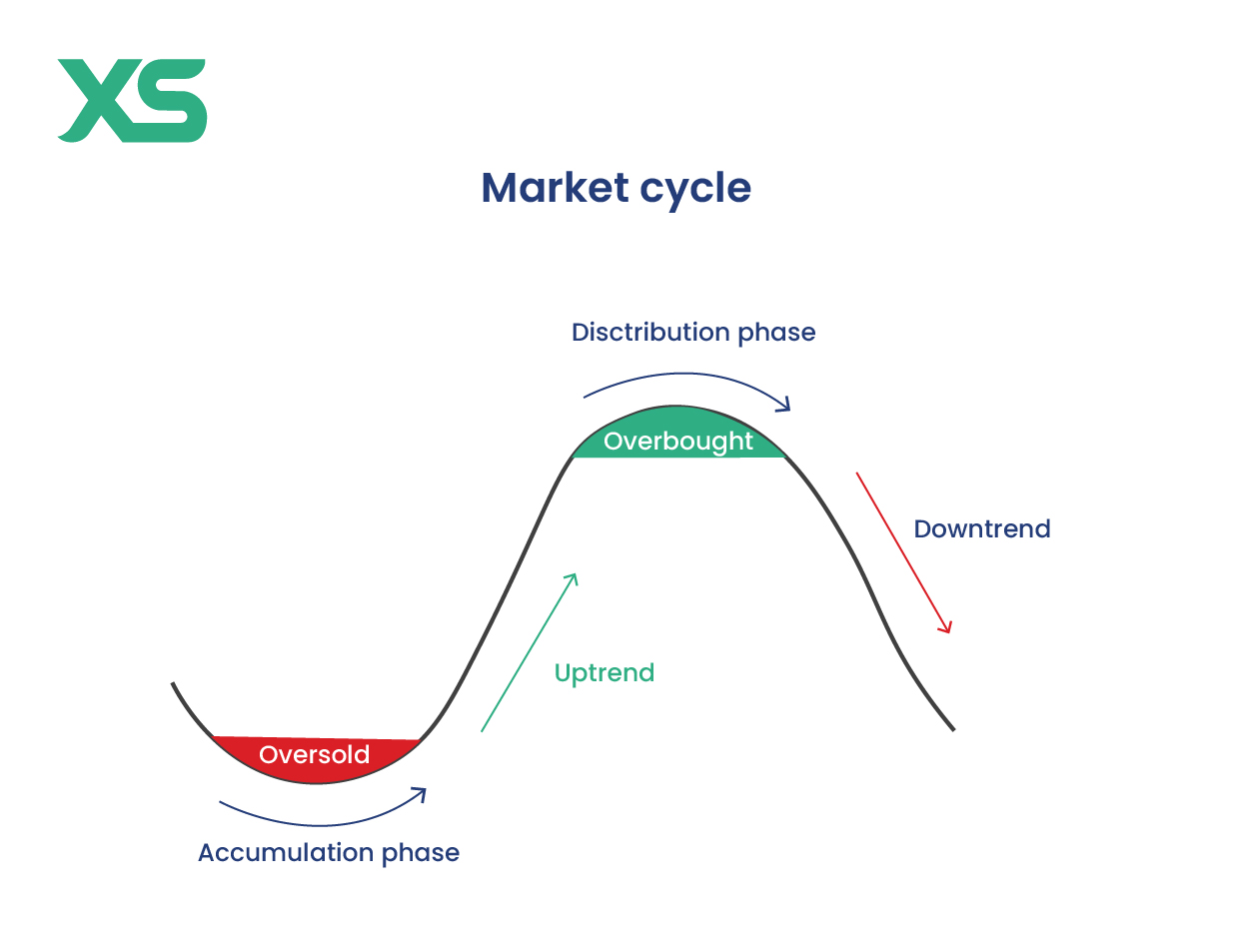
When you spot a bullish CHoCH, it signals a shift from a bearish to a bullish market, meaning prices are likely to start rising. On the other hand, a bearish CHoCH suggests a switch from bullish to bearish, indicating that prices may fall.
CHoCH vs. Break of Structure
One common confusion among traders is the difference between change of character (CHoCH) and Break of Structure (BoS).
A Break of Structure happens when the price moves beyond a key support or resistance level, indicating a shift in the market’s current trend. Typically, a BoS confirms the continuation of an existing trend.
For example, in an uptrend, if the price breaks above a previous high (resistance), it confirms the strength of the trend.
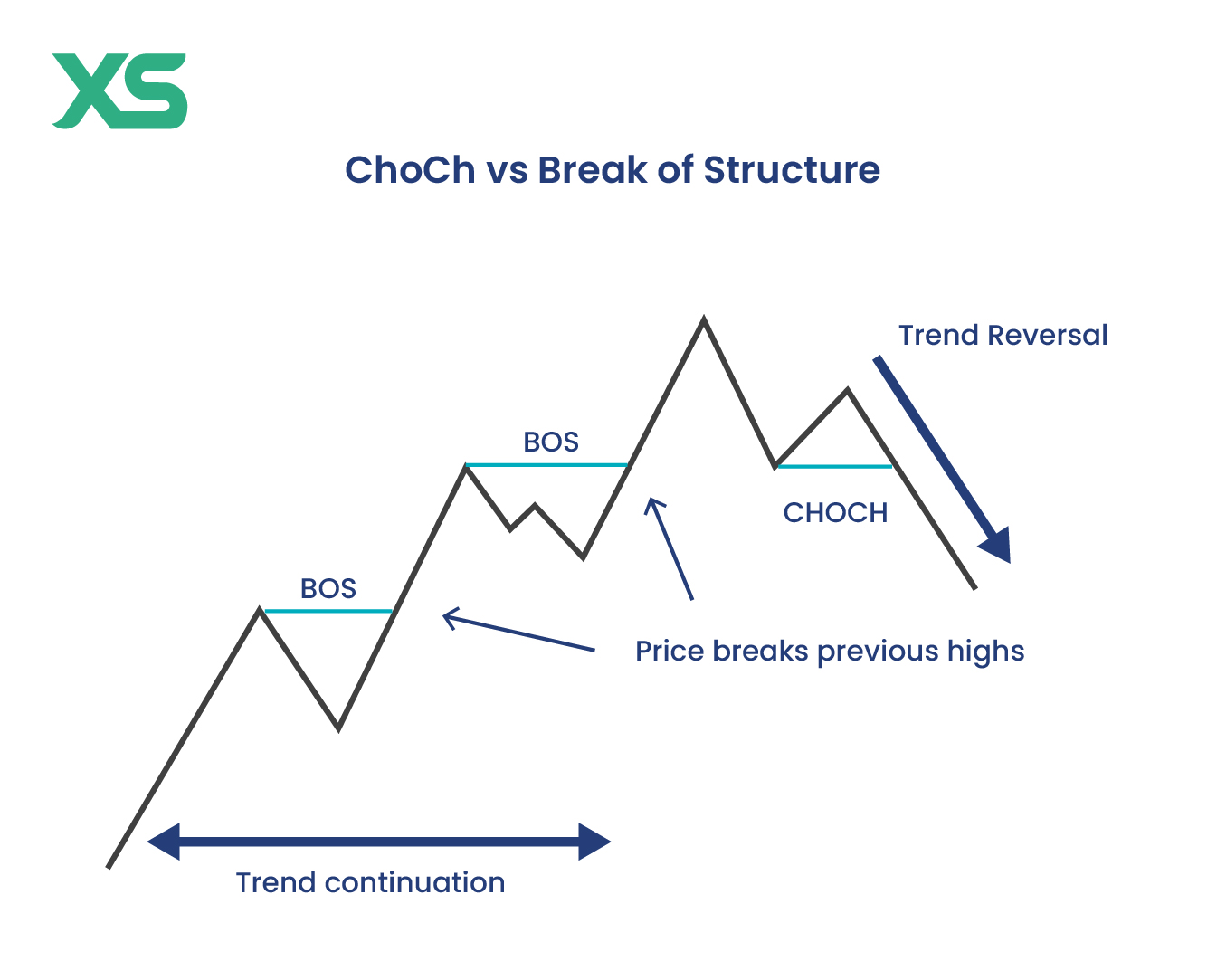
In essence, BoS focuses on trend confirmation, not necessarily signaling a change in direction. On the other hand, CHoCH signals a fundamental shift in market sentiment, suggesting that the current trend is weakening and a reversal may be on the horizon.
For example, if the market is in a clear uptrend and suddenly starts printing lower highs, it could signal a CHoCH. This indicates a potential shift from bullish to bearish sentiment.
CHoCH vs. Market Structure Shift
Similarly, Market Structure Shifts (MSS) also deal with changes in price action, but a CHoCH is more specific.
|
Feature |
MSS |
ChoCh |
|
Market Direction |
Any change (retracement, correction, or reversal) |
Critical moments (bullish to bearish or vice versa) |
|
Scope |
Whole market (trending, ranging, correcting) |
Trend reversals |
|
Focus |
Structural changes in price action |
Definitive change in direction and sentiment |
|
Signal Type |
General shifts in market behavior |
Clear signal for trend reversals |
An MSS refers to any change in the general market direction. This could be a minor retracement, a correction, or even a reversal. MSS deals with structural changes in the price action that may or may not result in a full trend reversal.
It looks at the market as a whole and identifies transitions between trending, ranging, or correcting phases.
On the other hand, choch zeroes in on those critical moments when the market changes its character, either from bullish to bearish or from bearish to bullish. CHoCH focuses on trend reversals, those points where the market sentiment fully flips, marking the end of the previous trend and the beginning of a new one.
While MSS might highlight general shifts in market behavior, CHoCH highlights a definitive change in direction and sentiment, offering a clearer signal to traders looking to capitalize on new trends.
The Psychology Behind CHoCH
The psychology behind CHoCH trading revolves around market participants' behavior. When a CHoCH occurs, it’s usually because the balance of power between buyers and sellers has shifted.
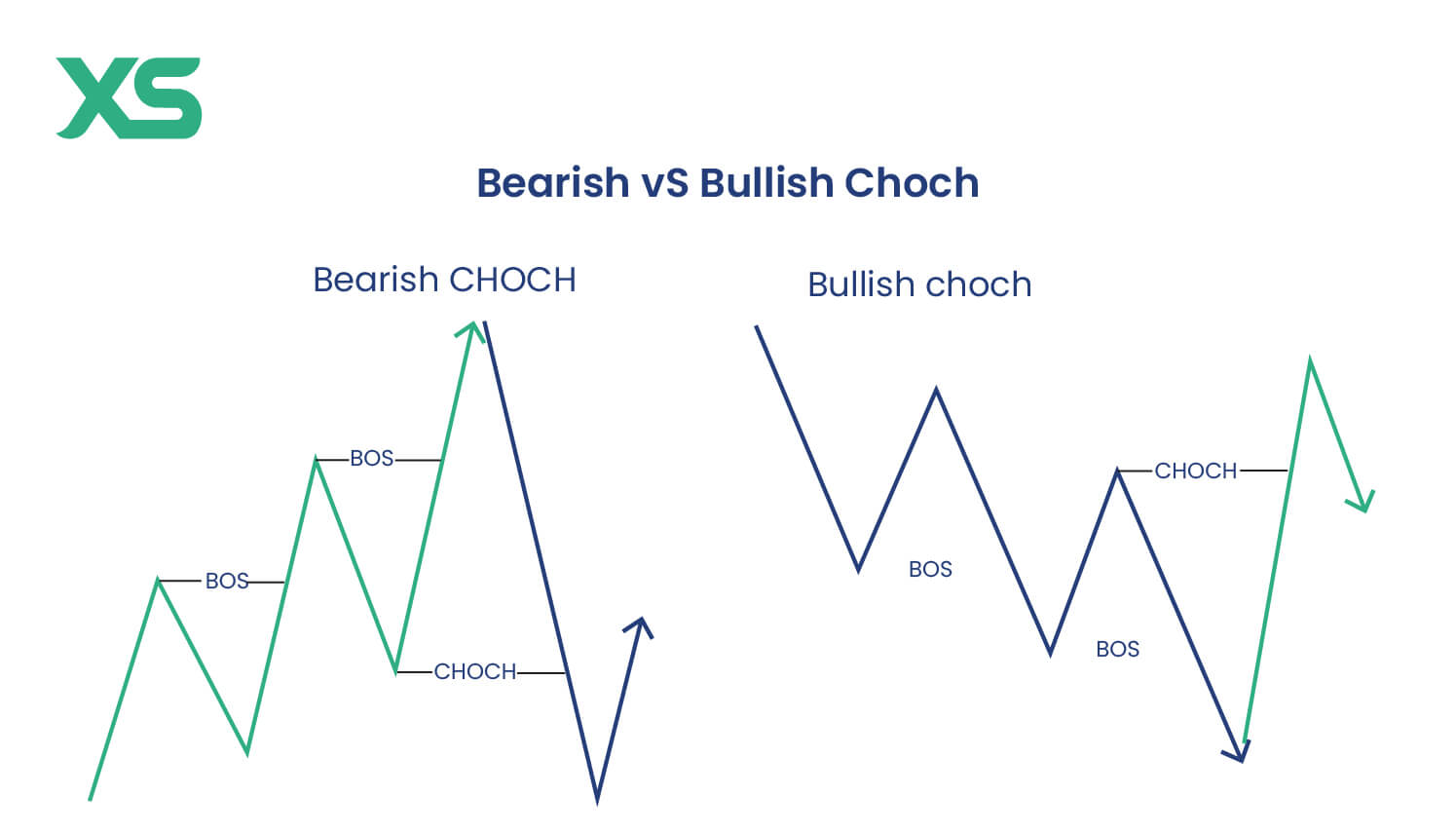
In a bullish CHoCH, sellers are exhausted, and buyers are ready to take control. In a bearish CHoCH, buyers lose momentum, and sellers take over. Recognizing this shift is crucial in identifying market reversals early.
How to Identify a CHoCH
Now that you know what a choch in trading is, it’s important to understand how to identify it. Identifying a CHoCH is all about recognizing a shift in price action.
4 Ways to Identify a Change of Character in Trading
Here are four ways that could help you identify a choch while trading.
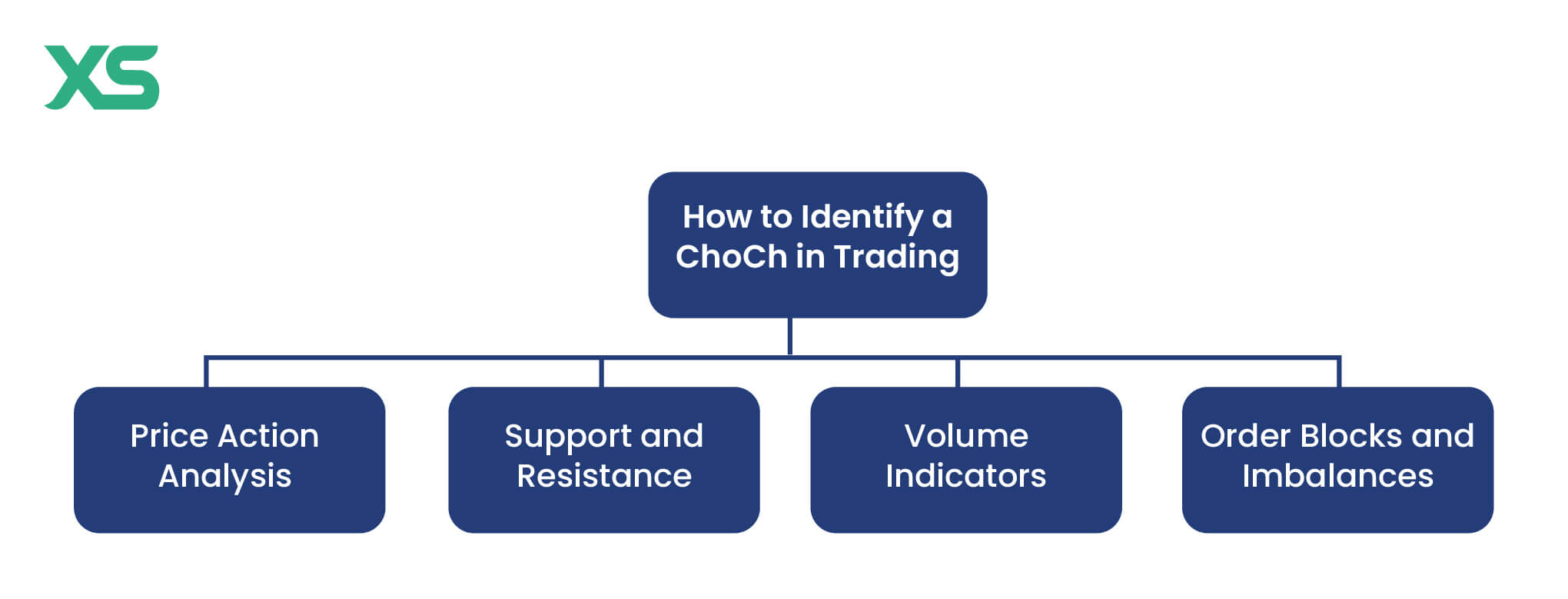
1. Price Action Analysis
Price action analysis involves studying market movements without relying on technical indicators. By analyzing the patterns of highs and lows in price, traders can identify shifts in market direction that signal a CHoCH.
For example, in an uptrend, if the price starts making lower highs and lower lows, it may indicate the beginning of a bearish CHoCH, suggesting a trend reversal from bullish to bearish.
On the other hand, in a downtrend, higher highs and higher lows could indicate a bullish CHoCH, signaling a shift from bearish to bullish sentiment.
2. Support and Resistance Levels
Support and resistance levels play a crucial role in identifying a CHoCH. A break above resistance or below support is often associated with a change in character in the market.
For instance, a market that has been respecting a support level but suddenly breaks below it may be undergoing a bearish CHoCH.
Similarly, a break above resistance could indicate a bullish CHoCH. These levels are key areas where price reactions occur, making them reliable zones for spotting potential trend reversals.
3. Volume Indicators
Volume indicators are useful for confirming the strength of a CHoCH. When the price breaks a key support or resistance level, a spike in volume can confirm that a true change in market sentiment is taking place.
A CHoCH accompanied by higher trading volume indicates strong participation in the market shift, making it more likely that the reversal is genuine.
Conversely, low volume during a supposed CHoCH could suggest that the market lacks conviction, and the signal might not hold.
4. Order Blocks and Imbalances
Order blocks and imbalances are advanced tools often used by institutional traders to identify key market turning points.
An order block represents a price zone where large buy or sell orders have been placed, creating significant market movement.
These zones often become points of interest for spotting CHoCHs because they indicate where institutions might be reversing their positions, which could cause a shift in market direction.
Imbalances occur when there is an unequal number of buy or sell orders, creating rapid price movement in one direction. When the market moves back to fill these imbalances, it may coincide with a CHoCH, suggesting a shift in market control.
By observing how the price reacts when revisiting order blocks or imbalances, traders can identify potential CHoCH signals.
Common Mistakes in Identifying CHoCH
When trying to spot a CHoCH, traders can sometimes make errors that lead to false signals or missed opportunities.
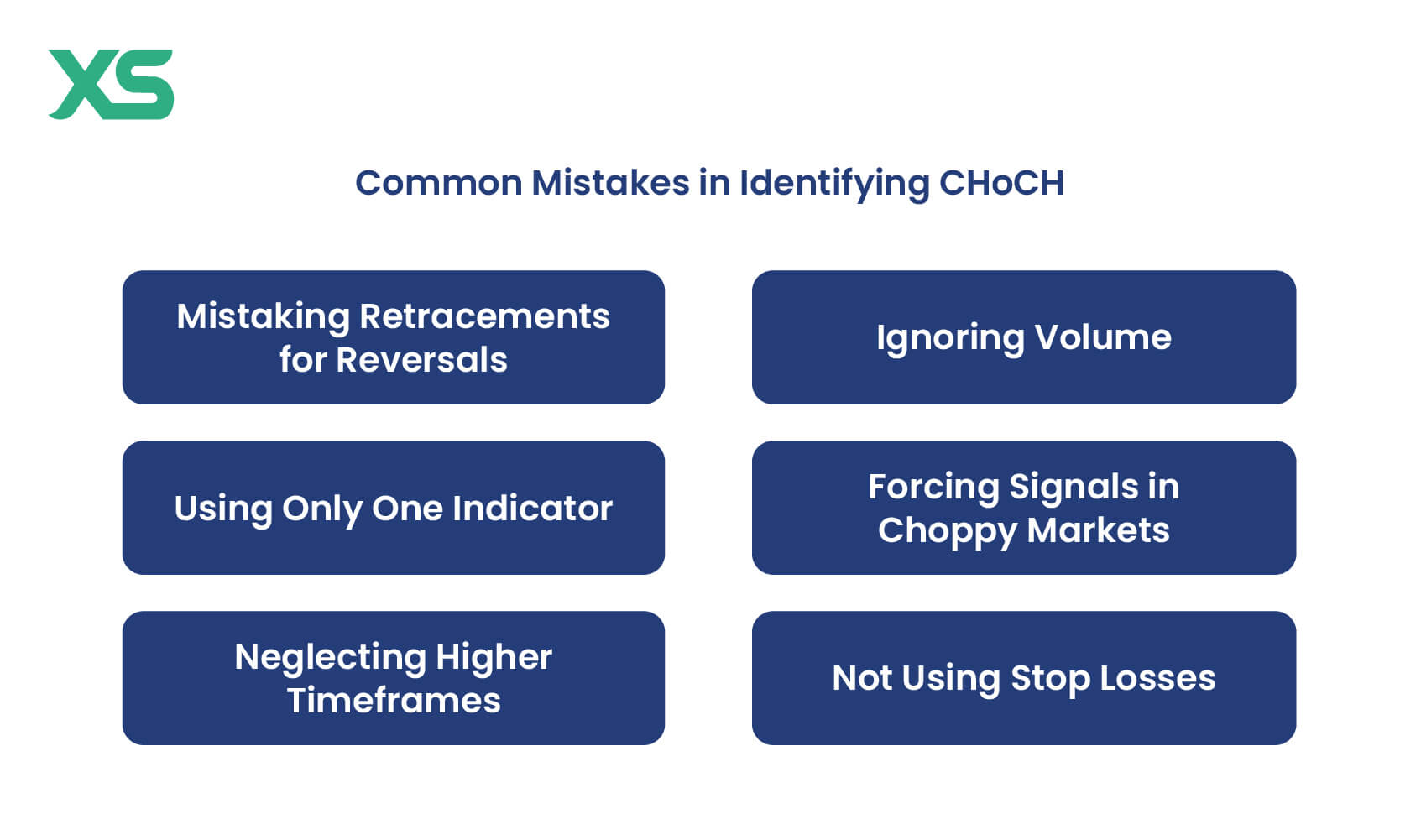
Below are some common mistakes to avoid:
-
Mistaking Retracements for Reversals: Not all pullbacks signal a CHoCH. Avoid confusing minor corrections with trend changes.
-
Ignoring Volume: A CHoCH without increased volume may indicate a weak or false signal.
-
Using Only One Indicator: Relying solely on price action without confirming with other tools like support/resistance or volume can lead to errors.
-
Forcing Signals in Choppy Markets: CHoCHs are harder to identify in sideways markets, where price action can be misleading.
-
Neglecting Higher Timeframes: Only focusing on lower timeframes can result in false signals. Higher timeframes provide better context.
-
Not Using Stop Losses: Always use stop-loss orders to manage risk, even with a confirmed CHoCH.
How to Trade a CHoCH
Trading a CHoCH involves waiting for confirmation of the trend reversal before entering a trade. A trading entry and exit point should be carefully planned.
Once a CHoCH is confirmed, you can enter a trade in the direction of the new trend, placing your stop loss just beyond the CHoCH level to minimize risk.
Trading CHoCH in Different Market Scenarios
CHoCH (Change of Character) trading can be applied across various market conditions, offering traders flexibility and a tool for identifying potential trend reversals.
Depending on the market scenario, the CHoCH pattern can signal different opportunities.
-
Trending Markets: In a trending market (either bullish or bearish), a CHoCH signals the end of the current trend and the potential start of a reversal.
-
Ranging Markets: In sideways or consolidating markets, CHoCH can signal a breakout from the range. When price action is trapped between support and resistance, a CHoCH may indicate the market is about to break out of the range and begin trending in a new direction.
-
Volatile Markets: During high volatility, CHoCH can provide clarity by identifying significant trend shifts amidst noise. However, it’s crucial to use volume confirmation and combine CHoCH with other indicators to avoid false signals in these scenarios.
By adjusting your CHoCH strategy to fit the current market condition, you can take advantage of both trend continuation and reversal opportunities.
Trading CHoCH in Different Timeframes
CHoCH trading is adaptable across different timeframes, offering opportunities for both long-term and short-term traders.
Understanding how CHoCH behaves on higher and lower timeframes helps you refine your strategy and choose timeframes that align with your trading style.
Higher Timeframe CHoCH
On higher timeframes (e.g., daily, weekly, or monthly charts), a CHoCH tends to signal more reliable and significant trend reversals.
These timeframes capture larger market movements and are generally used by swing traders or position traders looking for long-term opportunities.
A higher timeframe CHoCH offers the advantage of filtering out market noise and providing a clearer view of the overall trend.
For example, a bullish CHoCH on a daily chart after a sustained downtrend can signal a strong, long-term reversal. Traders who use this approach are typically less concerned with small fluctuations and focus on the bigger picture.
-
Pros: More reliable signals, less noise, greater trend stability.
-
Cons: Fewer trading opportunities, longer waiting periods for confirmations.
Lower Timeframe CHoCH
A lower timeframe CHoCH (e.g., 1-minute, 5-minute, or 15-minute charts) is favored by scalpers and day traders who seek quick, short-term moves in the market.
CHoCHs on lower timeframes can present frequent opportunities for entering and exiting trades, but they also come with increased risks of false signals due to market noise.
While lower timeframes provide more trade setups, traders must be cautious of whipsaws and fakeouts, using additional tools like volume or momentum indicators to confirm the validity of the CHoCH.
Scalpers often capitalize on these quick reversals to profit from intraday volatility.
-
Pros: More frequent trade setups, quick profit opportunities.
-
Cons: Higher risk of false signals, more market noise.
ChoCh Trading Strategies
CHoCH trading strategies can vary depending on a trader’s style, tools, and market approach.
There are two main groups of traders when it comes to applying CHoCH strategies: price action traders and indicator-based traders.
Price Action Traders
Price action traders rely on the movement of price alone to identify a CHoCH. They focus on the highs and lows in price action, candlestick patterns, and key support and resistance levels to detect shifts in market sentiment.
For these traders, the market's raw price data is the primary tool. They often combine CHoCH with key technical analysis strategies such as the Wyckoff method, supply and demand zones, or order flow.
Price action traders prefer to avoid lagging indicators and instead rely on immediate changes in the market to inform their decisions.
For example, a price action trader might wait for a lower high and a break below a recent low in a bullish market to confirm a bearish CHoCH, indicating a potential entry for a short position.
Indicator Traders
Indicator traders combine CHoCH with various technical indicators to confirm trend reversals. These traders use tools like moving averages, Relative Strength Index (RSI), MACD, or Bollinger Bands to validate a CHoCH signal.
For instance, an indicator trader may look for a CHoCH combined with an RSI moving into oversold or overbought territory. Or, they might use a crossover on the MACD to confirm the change in trend. Indicators help these traders avoid false signals by offering additional layers of confirmation.
For example, an indicator trader might spot a CHoCH on the 5-minute chart but wait for an MACD crossover or RSI divergence before entering the trade to ensure the reversal is valid.
Risk Management When Trading CHoCH
Proper risk management is critical when trading CHoCH patterns, as markets can be unpredictable even when a change in character is identified.
Here are some risk management techniques you can apply.
-
Stop-Loss Placement: Always use a stop-loss order to protect your position in case the CHoCH signal fails. For example, place a stop-loss slightly above or below the recent high or low to give the trade some breathing room, while still limiting potential losses.
-
Position Sizing: Don’t risk more than a small percentage of your trading capital on any one trade. Many traders follow the 1-2% rule, where they risk only 1-2% of their total account balance per trade.
-
Risk-Reward Ratio: Ensure a favorable risk-reward ratio before entering a CHoCH trade. A common target is a 1:2 or 1:3 ratio, meaning you aim to earn twice or three times the amount you are risking.
How to Place a Choch Trade: Step-by-Step
Now that you know all the details about choch trading, here’s a step-by-step guide:
-
Identify the Market Trend: Determine if the market is in an uptrend or downtrend by analyzing price action (higher highs, higher lows for uptrends; lower highs, lower lows for downtrends).
-
Look for a Market Structure Shift: In an uptrend, watch for the price to start making lower highs and lows (bearish CHoCH). In a downtrend, look for higher highs and lows (bullish CHoCH).
-
Confirm with a Break of Structure: Confirm the CHoCH by seeing the price break below support (for bearish CHoCH) or above resistance (for bullish CHoCH).
-
Use Volume/Indicators for Confirmation: Use volume spikes or indicators like RSI or MACD to confirm momentum. This helps filter out false signals.
-
Set Entry Points: Enter the trade after a slight retracement following the break of support or resistance. This allows better risk positioning.
-
Set Stop-Loss: Place your stop-loss above the most recent high for bearish CHoCH or below the recent low for bullish CHoCH to minimize risk.
-
Determine Profit Target: Set a profit target based on a favorable risk-reward ratio (e.g., 1:2 or 1:3), aiming to capture gains while managing risk.
-
Monitor the Trade: Keep an eye on price action and use a trailing stop-loss to lock in profits as the trade moves in your favor.
Lastly, exit when the price hits your target or if there’s a sign of another trend reversal. You can also use a trailing stop to capture further gains.
Advantages of ChoCh Trading
Choch trading presents the following advantages to traders:
-
Early Reversal Detection: CHoCH helps identify market reversals early, allowing traders to enter or exit trades at optimal points.
-
Works Across Markets: Applicable in various markets, including forex, stocks, and cryptocurrencies.
-
Flexible Timeframes: Can be used on both lower and higher timeframes, catering to different trading styles (scalping, swing trading, etc.).
-
Enhances Risk Management: By spotting trend shifts early, traders can avoid being caught on the wrong side of a trend, reducing potential losses.
The Problem With Using ChoChs
Despite the advantages choch trading presents, it also presents the following problems:
-
False Signals: In choppy or ranging markets, CHoCH can produce false signals, leading to potential losses.
-
Lagging Confirmation: Relying solely on CHoCH without combining it with other indicators may result in late entries or missed opportunities.
-
Requires Experience: Accurately identifying a true CHoCH can be challenging for beginners due to market noise and complex price action.
-
Increased Risk in Lower Timeframes: On lower timeframes, CHoCH patterns are prone to more frequent fakeouts due to short-term volatility.
Conclusion
CHoCH trading offers a practical and effective way to catch trend reversals early, giving you an edge in volatile markets. By mastering this technique, you can make better-informed trading decisions and reduce risks.

Get the latest insights & exclusive offers delivered straight to your inbox.
Table of Contents
FAQs
CHoCH stands for Change of Character, a signal that indicates a potential trend reversal in the market.
While CHoCH signals a trend reversal, Break of Structure (BoS) refers to a continuation of a trend after breaking key support or resistance levels.
In smart money concepts, CHoCH refers to institutional trading strategies that involve identifying market reversals driven by large players.
Yes, CHoCH can be used in various markets, including forex, stocks, commodities, and cryptocurrencies.
This written/visual material is comprised of personal opinions and ideas and may not reflect those of the Company. The content should not be construed as containing any type of investment advice and/or a solicitation for any transactions. It does not imply an obligation to purchase investment services, nor does it guarantee or predict future performance. XS, its affiliates, agents, directors, officers or employees do not guarantee the accuracy, validity, timeliness or completeness of any information or data made available and assume no liability for any loss arising from any investment based on the same. Our platform may not offer all the products or services mentioned.












